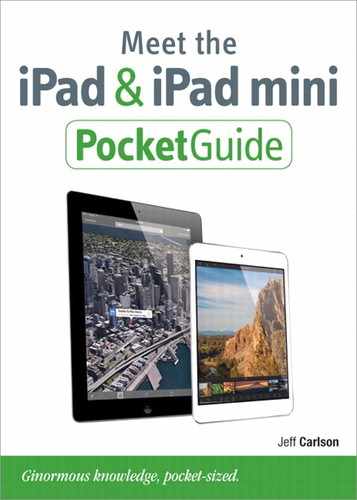Use the Cameras
The iPad and iPad mini each include two built-in cameras for capturing photos and video: one mounted on the back and one at the front. After a couple of generations of lackluster hardware, the cameras in the iPad Air and iPad mini are now nice and sharp. The front-facing FaceTime HD camera is great for making FaceTime video calls. The camera on the back captures 5 megapixels of data, features great lens elements, and captures 1080p video with automatic image stabilization. (The cameras on the iPad 2, however, just barely pass muster.)
And yet, specifications quickly lose their importance when you’re video-chatting with a friend in another city or capturing a photo or video that you otherwise might have missed. Specs improve over time, but events happen now.
Shoot photos and video
Many apps take advantage of the cameras—if you haven’t already played with Photo Booth, definitely check it out for a lot of fun—but I’ll cover the basics using the iPad’s Camera app.
Capture photos
You know how camera manufacturers boast that their cameras have large 2.5-inch or 3-inch LCD screens? How about a 7.9-inch or 9.7-inch screen? When you open the Camera app, nearly the entire screen is a preview of what you’re about to capture. Here are the basics of getting a shot; I’ll go into some of the options shortly.
1. Tap the Camera app to open it. (The first time you use the app, you’re asked to give permission to use your location. Go ahead; every photo is tagged with its GPS position.)
2. Select a mode by swiping up or down in the middle of the screen:
• Photo: The default mode uses the entire screen.
• Square: Inspired by Instagram’s square format, Apple added a Square option to the Camera app, which crops the edges.
• HDR: Tap the HDR Off button to enable the HDR (High Dynamic Range) mode, which works with either the Photo or Square formats. The iPad captures two images at two different exposures, and then blends them for a better overall exposure (helpful if a subject in the foreground is in dark shadows, for example). The original and the HDR version are both saved.
Tip
If you find yourself taking photos often with the iPad, you’ll soon want more than what the built-in Camera app offers. Check out the app Camera+ (campl.us) for advanced features like setting separate focus and white balance points.
3. Compose your shot using the preview on the screen (Figure 28); the iPad senses whether it’s in portrait or landscape orientation.
To toggle between the rear and front cameras, tap the Camera Switch button.
If you see one or more yellow boxes appear, the Camera app is identifying what it thinks is a person’s face. When you take the shot, it uses that area as the focus point.
4. Press the shutter button to take a shot.
The photo is saved in the iPad’s Camera Roll, which is accessible by tapping the preview button in the lower-right corner of the screen or by opening the Photos app.
Tip
If you press and hold the shutter button, the iPad starts capturing images (about two per second) until you lift your finger.
Capture video
Shooting video is similar to capturing still photos.
1. In the Camera app, switch to the video mode.
2. Optionally, choose which camera to use by tapping the Camera Switch button.
3. Tap the Record button (which now includes a red recording indicator instead of a camera icon) to start recording.
4. Tap the Record button again to stop. As with photos, the video you shoot is added to the Camera Roll.
Tip
Under iOS 7, you can tap the screen to set or lock focus and exposure in the Video mode, and also use digital zoom (which wasn’t available in earlier versions). Those controls apply after you’ve begun recording, too.

